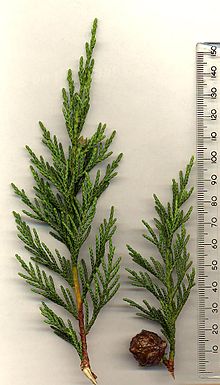
Leyland cypress

The Leyland cypress, Cupressus × leylandii, often referred to simply as leylandii, is a fast-growing coniferous evergreen tree much used in horticulture, primarily for hedges and screens. Even on sites of relatively poor culture, plants have been known to grow to heights of 15 metres (49 ft) in 16 years. Their rapid, thick growth means they are sometimes used to achieve privacy, but such use can result in disputes with neighbours whose own property becomes overshadowed. The tree is a hybrid, almost always sterile, and propagated mainly from cuttings. In 1845, the Leighton Hall, Powys estate was purchased by the Liverpool banker Christopher Leyland. In 1847, he gave it to his nephew John Naylor (1813–1889). Naylor commissioned Edward Kemp to lay out the gardens, which included redwoods, monkey puzzle trees and two North American species of conifers in close proximity to each other – Monterey cypress and Nootka cypress. The two parent species would not likely cross in the wild as their natural ranges are more than 400 miles (640 km) apart, but in 1888 the hybrid cross occurred when the female flowers or cones of Nootka cypress were fertilised by pollen from Monterey cypress. John Naylor's eldest son Christopher John (1849–1926) inherited Leighton Hall from his father in 1889. Christopher was a sea captain by trade. In 1891 he inherited the Leyland Entailed Estates established under the will of his great-great-uncle, which passed to him following the death of his uncle Thomas Leyland. On receiving the inheritance Christopher changed his surname to Leyland, and moved to Haggerston Castle, Northumberland. He further developed the hybrid at his new home, and hence named the first clone variant 'Haggerston Grey'. His younger brother John (1856–1906) resultantly inherited Leighton Hall, and when in 1911 the reverse hybrid of the cones of the Monterey cypress were fertilised with pollen from the Nootka, that hybrid was baptised 'Leighton Green.' The hybrid has since arisen on nearly 20 separate occasions, always by open pollination, showing the two species are readily compatible and closely related. As a hybrid, although fertility of certain Leyland cypress forms were recently reported, most Leyland cypress were thought to be sterile, and nearly all the trees we now see have resulted from cuttings originating from those few plants. There are over forty forms of Leyland cypress, and as well as 'Haggerston Grey' and 'Leighton Green', other well-known forms include 'Stapehill', which was discovered in 1940 in a garden in Ferndown, Dorset by M. Barthelemy and 'Castlewellan', which originated from a single mutant tree in the Castlewellan estate arboretum in Northern Ireland. This form, widely propagated from the 1970s, was selected by the park director, John Keown, and was named Cupressus macrocarpa 'Keownii', 1963. A large, evergreen tree, Cupressus leylandii reaches a size between 20 and 25 meters high, with its leaves giving it a compact, thick and regular habit. It grows very fast with yearly increases of one meter. The leaves, about 1 mm long and close to the twig, are presented in flaky, slightly aromatic branches. They are dark green, somewhat paler on the underside, but can have different colors, depending on the cultivar. The crown of many forms is broadly columnar with slightly overhanging branch tips. The branches are slightly flattened and densely populated with scaly needles. The tree bark is dark red or brown and has deep grooves. The seeds are found in cones of about 2 cm in length, with 8 scales and 5 seeds with tiny resinous vesicles. With the tree being a hybrid, its seeds are sterile. Over time, they turn gray or chocolate brown and then have a diameter of 1-5 cm. The taxonomic status of Nootka cypress has changed over time. In the past, it was regarded as belonging in the genus Cupressus, and later placed in Chamaecyparis. It has become clear, however, that when the genus Cupressus is defined to include Chamaecyparis, it is paraphyletic unless it also includes Juniperus. In 2004, Little et al. transferred the Nootka cypress to Callitropsis. Little (2006) proposed another alternative by transferring all the North American species of Cupressus, including the Monterey cypress (C. macrocarpa), to Callitropsis. In some of these classifications, the hybrids become very unusual in being intergeneric hybrids, the only ones ever reported among the gymnosperms. In 2010, Mao et al. performed a more detailed molecular analysis and redefined Cupressus to exclude Chamaecyparis, but to include the Nootka cypress. It may be added that attempts to cross Nootka cypress with other Chamaecyparis species have been universally unsuccessful. Where Nootka cypress is treated in Chamaecyparis, the name of the hybrid becomes ×Cupressocyparis leylandii, and where treated in Xanthocyparis, the hybrid becomes ×Cuprocyparis leylandii.
